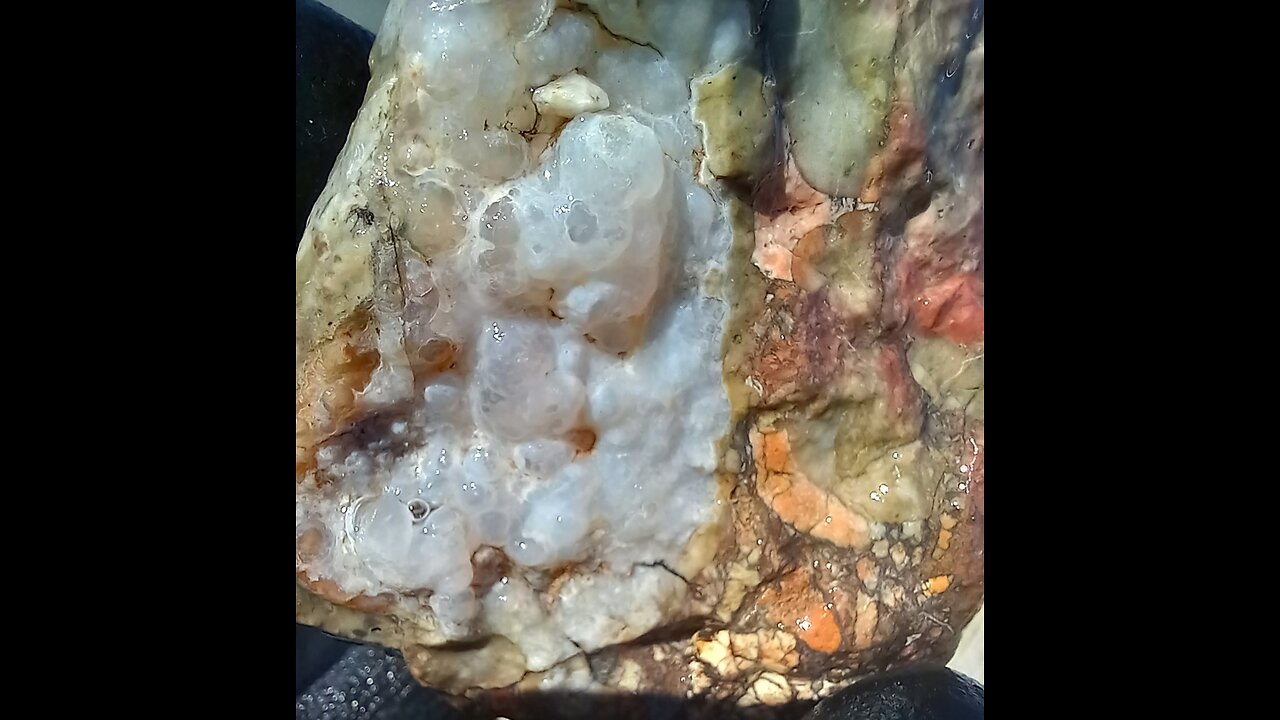Premium Only Content

Botryoital Opal w/ A Little of Everything!
Opal is a hydrated amorphous form of silica, with a water content typically between 3 and 21% by weight, most commonly around 6-10%. It's deposited at relatively low temperatures and can be found in the fissures of various rock types, including limonite, sandstone, rhyolite, marl, and basalt. Here's a deeper look into opal:
Types of Opal:
Precious Opal: Known for its "play-of-color," which is an optical phenomenon where colors flash or change as the angle of light or observation changes. This effect is due to the diffraction of light through the microscopic silica spheres within the opal.
Common Opal: Lacks the play-of-color and can come in a variety of colors like white, black, grey, yellow, orange, red, or brown. It's often referred to as "potch" when not gem-quality.
Fire Opal: Typically ranges in color from yellow to orange to red and can be transparent to translucent. Fire opals can exhibit play-of-color, but their name comes from the fiery body color.
Boulder Opal: A type of opal naturally attached to its host rock. It's often cut with the host rock to provide stability and to enhance the visual appeal.
Matrix Opal: The opal fills the cracks and cavities within the host rock, creating a network of opal that's visible on the surface.
Formation:
Primary Opal: Forms through the slow deposition of silica from groundwater in cavities or fractures of rocks.
Secondary Opal: Can form by weathering or alteration of other minerals, often in more superficial environments or through the action of silica-rich waters.
Locations:
Australia: The world's leading source, especially for precious opal, with significant deposits in places like Coober Pedy, Lightning Ridge, and White Cliffs.
Ethiopia: Known for its black opals and more recently discovered opal fields.
Mexico: Famous for fire opals.
Brazil: Produces a variety of opals, including crystal opal.
Properties:
Hardness: Typically ranges between 5.5 to 6.5 on the Mohs scale, though it can be softer if less hydrated or harder if more silica-rich.
Luster: Can range from waxy to resinous to vitreous.
Transparency: Varies from opaque to semi-translucent to transparent.
-
 16:57
16:57
Clownfish TV
9 hours agoLord of the Rings is RACIST Again According to UK College Course... | Clownfish TV
89010 -
![[Ep 774] Trump’s Ballroom Blitz | 9th Circuit OK’s Guard in Portland | Guest: Sam Anthony](https://1a-1791.com/video/fww1/00/s8/1/2/Z/E/s/2ZEsz.0kob-small-Ep-774-Trumps-Ballroom-Blit.jpg) LIVE
LIVE
The Nunn Report - w/ Dan Nunn
1 hour ago[Ep 774] Trump’s Ballroom Blitz | 9th Circuit OK’s Guard in Portland | Guest: Sam Anthony
117 watching -
 1:05:27
1:05:27
DeVory Darkins
3 hours ago $31.77 earnedTrump scores HISTORIC IMMIGRATION WIN as Democrats STUNNED by ballroom renovations
107K49 -
 43:40
43:40
The Rubin Report
2 hours agoDark Future Predictions & Exposing the Truth About Australia’s Past | Tony Abbott
23.3K13 -
 1:57:45
1:57:45
The Charlie Kirk Show
4 hours agoThis is What Democracy Looks Like + Oxford Union Election Fraud? | Dr. Orr, Ogoloma, Harmon | 10.21
75.5K25 -
 26:07
26:07
Lady Decade
11 hours agoGaming Feminists Just Discovered Islam - & It’s Not Going Well
26.6K7 -
 3:52
3:52
Michael Heaver
3 hours agoErupting UK Voters Send FEROCIOUS Message
7.81K5 -
 1:05:52
1:05:52
Timcast
4 hours agoJudge Rules DHS Agents CAN BE ARRESTED, Trump WINS On Right To Deploy National Guard
143K108 -
 2:01:37
2:01:37
Steven Crowder
6 hours agoWe Have the Proof: These are the Immigrants Destroying America and The West
378K324 -
 LIVE
LIVE
Side Scrollers Podcast
1 day ago🔴SIDE SCROLLERS FUND-A-THON🔴DAY 2🔴100% REVENUE HELPS CHANGE CULTURE!
1,232 watching